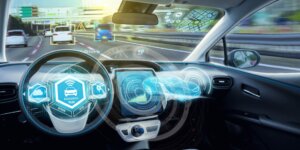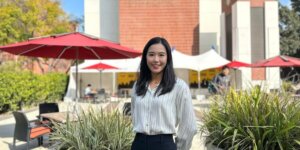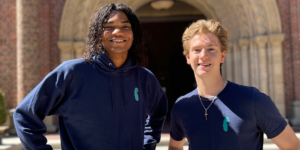
Photo Credit: PixelCatchers/iStock
Experts forecast that in the coming years there will be tens of thousands more jobs in the semiconductor and microelectronics industry than people qualified to fill them. One way to help meet that future demand is by sparking interest and enthusiasm in young people to continue in STEM-focused education, which is often a precursor to career pathways in advanced manufacturing.
To address this reality, the California Defense Ready Electronics and Microdevices Superhub (DREAMS) — a USC-led coalition involving 16 university and industry collaborators to accelerate microelectronics research and development — is focusing on reaching students, where experts say it matters the most: middle school math classrooms and programs.
“We lack effective tools and platforms where the community contributes to making math relevant while using artificial intelligence (AI) to improve learning,” said Andrea Belz, California DREAMS director of translational strategy and USC Viterbi Vice Dean of Transformative Initiatives. “We also know students want to see and touch science, and we are providing that opportunity.”
California DREAMS is teaming with nonprofit Change The Tune and several academic researchers to evolve the way classroom and enrichment programs approach math instruction, while demonstrating the importance of math for fields of study relevant to microelectronics.
“How do you create a space where demography doesn’t determine destiny?” asked Charli Kemp, executive director of Change The Tune, which hosts afterschool programs, summer camps and capacity-building for underserved student communities. “We know that there is a huge gap with BIPOC (black, indigenous and other people of color) people in STEAM (science, technology, engineering, arts and mathematics), especially in academic areas that lead to semiconductor and microelectronics fields. Often programs are designed without centering the community’s voices. Then the community is not interested and the pipeline is empty. We can close those gaps, starting with how we learn.”
Led by USC Viterbi’s Information Sciences Institute (ISI), DREAMS is one of eight regional innovation hubs established under the Department of Defense Microelectronics Commons Program, which is funded by the CHIPS and Sciences Act of 2022 to develop onshore microelectronics hardware prototyping, lab-to-fab transition of semiconductor technologies and extended semiconductor workforce training.
Tools and strategies
California DREAMS conducted its first focus groups and surveys of middle school math students and instructors in April 2024 at Audubon Middle School in the Leimert Park neighborhood of Los Angeles. Experts solicited feedback on students’ preferences to engage with math, and learned about best practices from instructors.
Now, the research team is examining various levers of change, including use of educational software; the associated curriculum and teacher training; and methods for teachers to leverage their creativity.
“If students don’t like it, they’re not tapping in,” Kemp said. “So, creating a training model that centers their voices and teachers’ voices to create that joy is the big goal.”
Researchers are also analyzing math software platforms already in use to inform the design of their own mathematics application. Ben Nye, director of learning sciences at the USC Institute for Creative Technologies, is leading the development of the Meridio, a platform that enables collaboration between students, with an AI-enabled backend to help teachers.
Solving real-life math problems
Although still in early development, Meridio is expected to emphasize two major features: the ability for students to work on math problems while interacting as if they are on social-media, and content personally and culturally relevant to students. The Meridio team plans to create relevance by teaching real-world problems that excite and inspire the students.
“If you’re not teaching students something in a way that shows how it aligns with their values and what they’re trying to do, it’s not going to be relevant to them,” Nye said. “Meridio will help you see where math is in the problems you find in everyday life and beyond. The idea is for these students to see the world through math goggles.”
The Meridio platform will provide the space for instruction and social applications. For example, perhaps a neighborhood has potholes that occasionally interfere with students’ daily transit. A lesson could potentially focus on fixing that specific issue, using geometry for the potholes’ shapes and analyzing costs for supplies to fill them. Each step to solving this real problem could become a math problem where students could collaborate.
Ultimately, Nye and the team will create the software platform to help generate those real-world math problems based on prompts from the users about subjects in their own lives. The software could potentially employ large language models (LLM) and AI to build problems for the students.
“Our paradigm shift here is to get students to understand and collaborate on math problems, working back from things they care about,” Nye said.
Exploring math and microelectronics
Building excitement for STEM must also extend beyond classroom activities. Kemp explained that 80 percent of students’ waking hours are spent outside of school, so after school programs and summer camps are a big priority of the California DREAMS strategy.
This summer, California DREAMS is collaborating with Change The Tune’s Studio Summer Camp, which will include 60 participants from more than 15 Los Angeles-area schools. On a special USC Discovery Day, California DREAMS will host the summer camp students at the USC John O’Brien Nanofabrication Laboratory, where they will hear from experts in the field and participate in a Cleanroom Scavenger Hunt, among other activities.
“Seeing the work firsthand and hearing from people who represent the local community can go a long way to inspiring students,” Kemp said. “We want these programs to be hotbeds that generate interest in technology and microelectronics.”
As California DREAMS accelerates its K-12 activities, the team will build models that scale anywhere and for anyone. The early results are promising. “The power of this project is that so many people from so many different spaces are coming together,” Kemp said.
Published on July 17th, 2024
Last updated on July 17th, 2024













